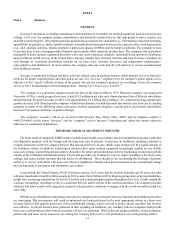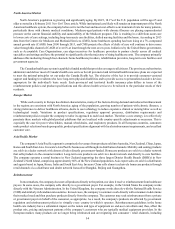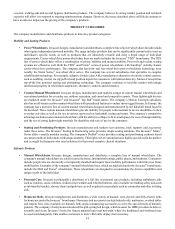Invacare 2015 Annual Report Download - page 19
Download and view the complete annual report
Please find page 19 of the 2015 Invacare annual report below. You can navigate through the pages in the report by either clicking on the pages listed below, or by using the keyword search tool below to find specific information within the annual report.I-13
Other FDA Matters
In December 2010, the company received a warning letter from the FDA related to quality system processes and procedures
at the company's Sanford, Florida facility. In October 2014, the FDA conducted an inspection at the Sanford facility and, at the
conclusion, issued four inspection observations on Form 483, three of which related to complaint handling and Corrective And
Preventative Actions (CAPA) process and a fourth related to production process controls. The company has filed its response with
the FDA and continues to work on addressing the FDA observations. At the time of filing of this Annual Report on Form 10-K,
this matter remains pending. See Item 1A. Risk Factors.
In January 2014, the FDA conducted inspections at the company’s manufacturing facility in Suzhou, China and at the
company’s electronic components subsidiary in Christchurch, New Zealand, covering quality systems and current Good
Manufacturing Practice (cGMP) regulations. In August 2014, the FDA inspected Alber GmbH in Albstadt, Germany. The FDA
issued its inspection observations on Form 483 to the company after these inspections, and the company submitted its responses
to the agency in a timely manner.
In December 2015, the FDA issued a Form 483 with observations following a 2015 inspection of approximately five months
duration at the Corporate and Taylor Street facilities in Elyria, Ohio which included a review of the company’s compliance with
terms of the consent decree and the matters covered by the first and second expert certification reports previously accepted in
2013. The company has filed its response to this Form 483 with the FDA and continues to work on addressing the FDA's observations.
From time to time, the company may undertake voluntary recalls or field corrective actions of the company’s products to
correct product issues that may arise. These actions are necessary to ensure the company's products adhere to high standards of
quality and safety. The company continues to operate these programs to ensure compliance with applicable regulations and actively
keeps abreast of proposed regulations, particularly those which could have a material adverse effect on the company.
National Competitive Bidding
With respect to reimbursement in the United States, the Centers for Medicare and Medicaid Services (CMS) is a significant
payor and governs healthcare reimbursement for Medicare and Medicaid services. On January 1, 2011, CMS began its National
Competitive Bidding (NCB) program in nine metropolitan statistical areas across the country (Round 1) for the purpose of reducing
healthcare spending. On July 1, 2013, CMS expanded the program to an additional 91 metropolitan statistical areas (Round 2).
These bid programs have resulted in new, lower Medicare payment rates in these 100 areas. CMS rebids these areas at least every
three years. In January 2016, CMS began the deployment of NCB rates to the remainder of the Medicare population that had not
yet been impacted by the program, primarily to rural areas. CMS has divided the United States into eight regions and is applying
the average reimbursement reduction per NCB product category in each region from Round 1 and Round 2 to the rural providers
in those eight regions. Fifty percent of the reimbursement reduction became effective in January 2016. The remaining half of the
reduction is expected to be applied in July 2016. The company’s exposure to effects of NCB rate reductions and any similar
reductions from private payors or state agencies is primarily related to the increased credit risk of its customers whose revenue is
based on reimbursement. As reimbursement rates are reduced, the company’s customers will see pressure on the profitability and
liquidity of their businesses. The company therefore remains judicious in its extension of credit to its customers and is vigilant
about collections efforts.
Although reductions in Medicare payments are not beneficial to the homecare industry, the company believes it can still
grow and thrive in this environment. No significant cost-of-living adjustments have been made to reimbursement rates by CMS
over the last few years that affect the company’s products, and the company intends to continue its own productivity initiatives.
As a result of reimbursement reductions, the company’s customers are increasingly interested in cost-effective clinical solutions
for their clients. Some of the company’s solutions are particularly effective in providing clinical benefits to patients and cost-
effective healthcare provision for the company’s customer-providers. As an example, the company’s respiratory therapy products
can help offset reimbursement reductions by reducing or eliminating the need for routine delivery services to end-users. Delivery
costs can be a substantial element of cost for its customers. HomeFill oxygen systems and the company’s oxygen concentrators
can provide effective convenient therapy for consumers and cost-effective equipment solutions for providers. The company intends
to develop other products that help providers improve profitability.
BACKLOG
The company generally manufactures its products to meet near-term demands by shipping from stock or by building to order
based on the specialized nature of certain products. Therefore, the company does not have substantial backlog of orders of any
particular product nor does it believe that backlog is a significant factor for its business.
























